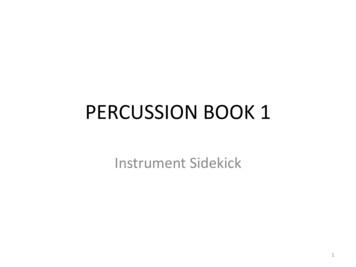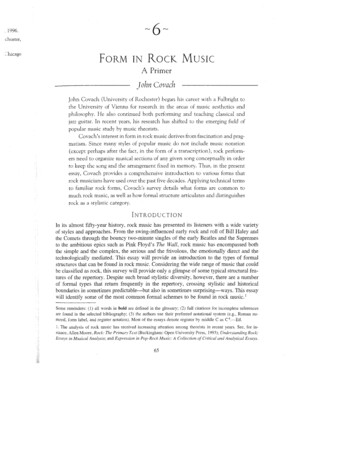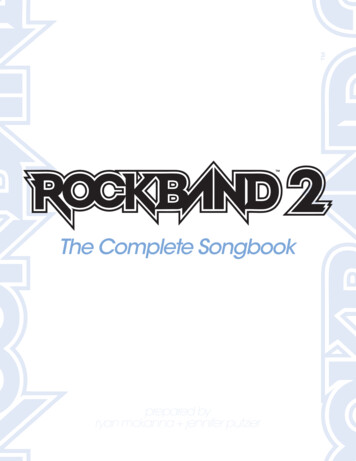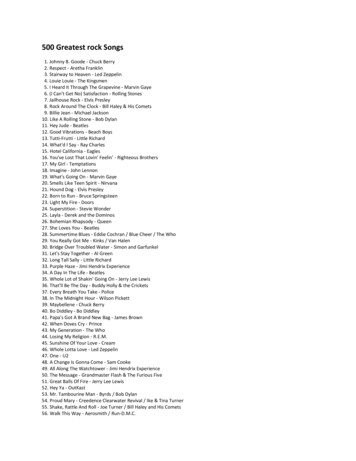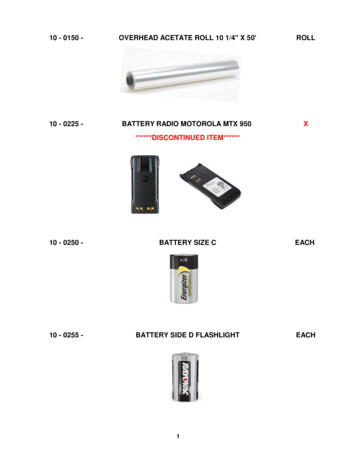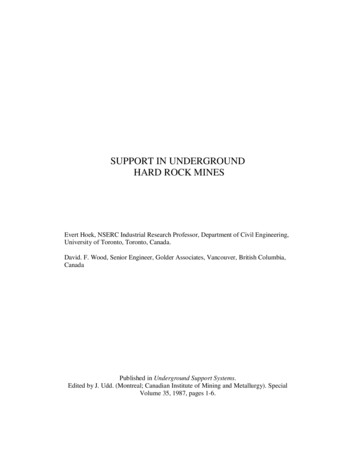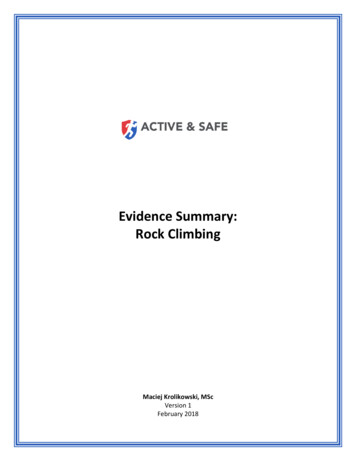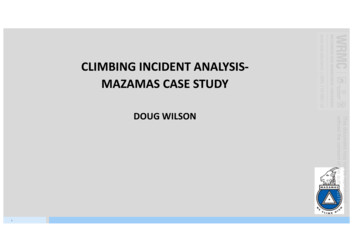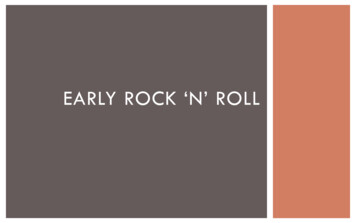
Transcription
EARLY ROCK ‘N’ ROLL
THE ELECTRIC GUITAR¡ ¡ ¡ ¡ Rock ’n’ roll elevated the electricguitar to a central position inAmerican popular music.Engineers began to experiment withelectronically amplified guitars in the1920s.The solid-body electric guitar§ Developed after World War II§ First used in R&B, blues, and countrybandsCame into the mainstream with asomewhat dubious reputation§ Carryover from the medievalEuropean association of stringedinstruments with the Devil§ Associated with the music ofmarginalized regions and people
CHICAGO ELECTRIC BLUES¡ Urban blues tradition of the postwar eran Derived more directly from the Mississippi Delta traditionof Robert Johnson¡ The rural blues tradition had almostcompletely died out as a commercialphenomenon by World War II.¡ The old Delta blues emerged in areinvigorated, electronically amplified form.
MUDDY WATERS (MCKINLEY MORGANFIELD)(1915–83)¡ “Discovered” in the Mississippi Deltaby Allan Lomax in 1941¡ Moved to Chicago in 1943¡ Played both acoustic and electricslide guitar¡ The single greatest influence on theBritish blues boom in the 1960s
LISTENING: “HOOTCHIE COOTCHIEMAN”¡ Muddy Waters, 1953¡ Features Muddy’s lineup in the early 1950s:§ Two electric guitars§ Bass, drums§ Amplified harmonica¡ Combines blues form with strophic verse-chorusstructure¡ Typical Chicago electric/urban blues
ROCK ’N’ ROLL, 1954–1959¡ ¡ ¡ ¡ ¡ The advent of rock ’n’ roll during the mid-1950s broughtabout enormous c hanges in American popular music.Styles previously considered on the margins ofmainstream popular music were infiltrating the center andeventually came to dominate it.R&B and country music recordings were no longer gearedtoward a specialized market.The target audience for rock ’n’ roll during the 1950sconsisted of baby boomers, Americans born after WorldWar II.Muc h younger target audience
COVER VERSIONS AND EARLYROCK ’N’ ROLL¡ Cover versions§ § § Copies of previously recorded performances;often adaptations of the originals’ style andsensibility, and usually aimed at cashing in ontheir successOften bowdlerized imitations of R&B songsHelped fuel the market for rock ’n’ roll
BIG JOE TURNER AND “SHAKE, RATTLE,AND ROLL”¡ Big Joe Turner (1911–85)¡ Called a “blues shouter”because of his spirited,sometimes raucous vocaldelivery¡ Born in Kansas City, started outsinging with local bands¡ “Shake Rattle, and Roll” wasTurner’s biggest rock ’n’ rollrecord for Atlantic.
LISTENING: “SHAKE, RATTLE, AND ROLL,” BILLHALEY AND THE COMETS (JUNE 1954)¡ The lyrics were bowdlerized by producer Milt Gabler to ensureairplay on white radio stations.¡ This song was only a minor hit when it was released.
BILL HALEY (1925–81)¡ ¡ ¡ ¡ Former DJ and western swingbandleader from PennsylvaniaDropped his cowboy image,c hanged the name of hisaccompanying group from theSaddlemen to the CometsIn 1954, the Comets weresigned by Decca Records.Moved toward the R&B jumpband sound§ Encouraged by A&R man MiltGabler
BILL HALEY AND THE COMETSRecorded commercially successful cover versionsof R&B hits in the mid-1950sLargest success came in 1955 with “Rock aroundthe Clock”, the first record to become a #1 pophitRecorded in 1954 and not a big hit when firstreleased¡ ¡ ¡ § ¡ Popularized in 1955’s Blackboard Jungle, a film about inner-cityteenagers and juvenile delinquencyRock Around The Clock
EARLY ROCK AND ROLLSTARS: THE RHYTHM ANDBLUES SIDE
CHARLES EDWARD ANDERSON(“CHUCK”) BERRY (B. 1926)Born in St. Louis, Missouri¡ § § Absorbed blues and R&BstylesOne of the first and mostsuccessful black musicians toconsciously forge his ownversion of blues and R&Bstyles for appeal to themass market
LISTENING AND ANALYSIS:“MAYBELLENE”¡ Verse-chorus form based on the twelve-bar blues¡ Chorus: “Maybellene, why can’t you be true”—follows twelve-bar blues chord pattern¡ Verse—no chord changes—all on the “home” (ortonic) chord¡ Verses build enormous tension, so that when thechoruses and chord changes return, there is afeeling of release and expansion.
RICHARD WAYNE PENNIMAN (“LITTLERICHARD”) (B. 1932)¡ ¡ Early career as an R&Bperformer§ Hit the pop charts in 1956with the song “Tutti-Frutti”§ Delivered in an uninhibitedshouting style, complete withfalsetto whoopsEpitomized the abandoncelebrated in rock ’n’ rolllyrics and music§ The sound of his recordingsand the visual characteristicsof his performances madeLittle Richard a stronginfluence on later performers.
LISTENING: “LONG TALL SALLY”Built on the twelve-bar blues, adapted toreflect the more traditionally pop-friendlyformat of verse-chorus¡ § The first four bars of each blues stanza are set tochanging words—verses—while the remaining eightbars, with unchanging words, function as a repeatedchorus.
EARLY ROCK AND ROLLSTARS: THE COUNTRYSIDE
ELVIS PRESLEY (1935-77)¡ Born in Tupelo, Mississippin Moved to Memphis, Tennessee as a teenager¡ The biggest rock ’n’ roll star tocome from the country side of themusic¡ Presley’s extraordinary popularityestablished rock’n’roll as anunprecedented mass-marketphenomenon.¡ Known as the “King of Rock andRoll”¡ Elvis is the best selling solo artistin the history of popular music
LISTENING: “DON’T BE CRUEL”¡ Based on the twelve-bar blues¡ Presley’s vocal is heavy with blues-derived and countryinflections.§ § § § Striking regional accent“Hiccupping” effect on “please”Strong backbeat from R&BOpening electric guitar figure from western swing bands¡ Imposed on all these diverse and intense stylisticelements is a wash of electronic reverbDon't Be Cruel
BUDDY HOLLY (CHARLES HARDIN HOLLEY)(1936–59)¡ Clean-cut, lanky, bespectacled¡ Began his career with countrymusic, fell under the influence ofPresley’s and formed a rock’n’rollband, the Crickets¡ “That’ll Be the Day,” rose toNumber One on the pop c harts inlate 1957 and established hissound.§ Combined elements of country,R&B, and mainstream pop
BUDDY HOLLY (CHARLES HARDIN HOLLEY)(1936–59)¡ Holly’s vocal style exhibits elements of both finecountry singing and fine blues singing, full of countrytwang and hiccups.¡ Mixture of toughness and vulnerability¡ The Crickets’ instrumental lineup§ Two electric guitars (lead and rhythm), bass, and drumsprovided strong support for Holly’s voice.§ During instrumental breaks, Holly’s lead guitar playingwas active, riff-based, and hard-edged in a way thatreflected the influence of Chuck Berry.
LISTENING: “THAT’LL BE THE DAY”¡ Form§ Structured like a typical pop song, alternating verses andchoruses of eight bars each§ At the instrumental break, the Crickets play a twelve-bar bluespattern¡ On some later records, like “Oh, Boy!” and “PeggySue,” Holly used a twelve-bar blues structure for thesong itself¡ That'll Be The Day
THE ELECTRIC GUITAR ! Rock ’n’ roll elevated the electric guitar to a central position in American popular music. ! Engineers began to experiment with electronically amplified guitars in the 1920s. ! The solid-body electric guitar ! Developed after World
